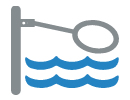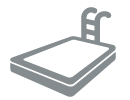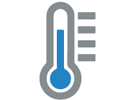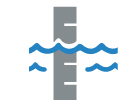Water-Saving Tips for Swimming Pools and Hot Tubs
An unidentified or unaddressed leak in your pool may cause you to have charges in the wasteful tier and incur over-allocation charges. For example, if your pool's water level is dropping more than a quarter of an inch per day, you may have a leak. Or, if your pool fill is running longer than usual, it's possible your float is stuck or needs to be adjusted. You may be eligible for a leak adjustment on your bill if you drained and refilled your pool to fix a leak. A copy of your invoice is required to qualify for a leak adjustment. To find out more about water leaks, visit irwd.com/services/water-leaks.
IRWD includes the surface of your pool in your total square feet of irrigated landscape.
Tips for residential pool and hot tub owners
Check your pool for leaks by performing the bucket test (video) or the dye test (video). Consider using a sensor-based autofill device to reduce unnecessary refilling of pools and increase leak detection. Forgetting to shut off fill water can make for a costly waste of water.
Splashing and water fights in your pool and spa can cause excessive amounts of water loss. To avoid splash out, reduce the water level of swimming pools to the lower half of the water line tile.
Use a pool cover to avoid evaporation and save energy on heating. A recent Cal Poly San Luis Obispo study found that solid pool covers can reduce swimming pool water evaporation by up to 95%.
Maintain proper pool chemistry year round to avoid the need to drain and refill your pool. Avoid draining the pool, unless needed for health and safety purposes, to fix leaks or for other major repairs.
Sweep instead of hosing down hard surfaces near the pool area.
If heated, reduce your pool and spa water temperature, especially while not in use. Warmer water evaporates more quickly.
The average backwash uses between 250 to 1,000 gallons of water per backwash, depending on pool and equipment size. Manually clean your filter to use less water and do a more thorough job.
Your swimming pool should lose no more than ¼ inch per day due to evaporation. Losing more than ¼ inch per day in a pool running with no water features or heaters is considered a leak. Check the pool skimmer for cracks and perform a bucket or dye test, or seek assistance from a leak detection expert.
Tips for HOAs
- • Create a Leak Detection and Prevention process and schedule for your management staff and/or pool service professional
- • Replace pool adjacent landscaping with water efficient plants, drip or micro-spray irrigation, and install a weather-based irrigation controller a
- • An average community-sized pool with no leaks nor malfunctioning equipment generally uses no more than 15 ccf/month. If your pool's water usage is greater than 15 ccf/month, please the Water Use Efficiency Department at 949-453-5581 to request an on-site evaluation.










